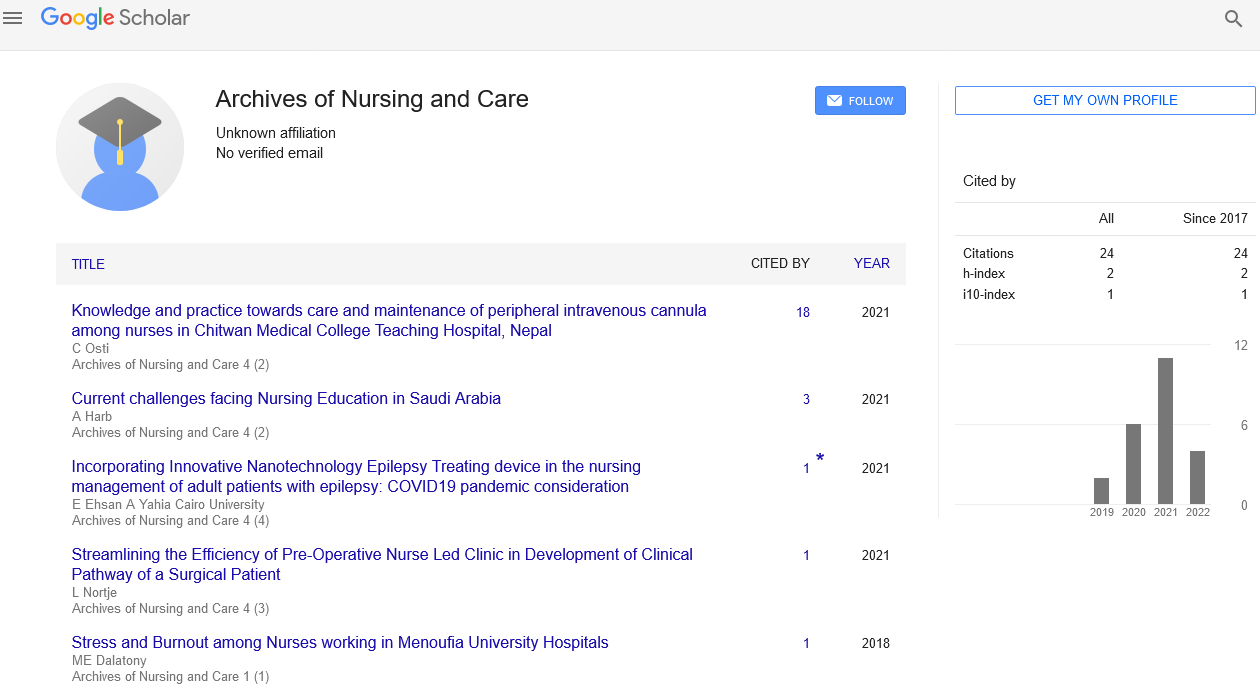Mini Review - Archives of Nursing and Care (2023) Volume 6, Issue 2
Relationship between Dysphagia with Serum Albumin Level among Older Patients Receiving Hospital Rehabilitation Patients: A Retrospective Study
Song Kechen*
Department of Clinical Neuroscience and Therapeutics, Graduate School of Biomedical and Health Sciences, Hiroshima University, Japan
Department of Clinical Neuroscience and Therapeutics, Graduate School of Biomedical and Health Sciences, Hiroshima University, Japan
E-mail: SongKechen@edu.cz.jp
Received: 03-Apr-2023, Manuscript No. OANC-23-92213; Editor assigned: 05-Apr-2023, PreQC No. OANC-23- 92213 (PQ); Reviewed: 19-Apr-2023, QC No. OANC-23- 92213; Revised: 24- Apr-2023, Manuscript No. OANC-23- 92213 (R); Published: 28-Apr-2023; DOI: 10.37532/oanc.2023.6(2). 38-40
Abstract
Dysphagia refers to swallowing difficulty, which impacts patients’ quality of life. Dysphagia influences clinical outcomes, including mortality rates and length of hospital stay of older hospitalized patients. Dysphagia may affect the current and future quality of life of these patients. However, its exact impact remains unclear. We aimed to clarify the impact of dysphagia on discharge to home in older patients in a rural rehabilitation unit. Recent years have witnessed an upsurge in the interest in the correlation between nutritional condition and rehabilitation of stroke patients. Dysphagia is one of the neurological manifestations, which markedly affects the nutrient intake of stroke patients. However, previous studies did not consider dysphagia as a variable. If the presence of dysphagia correlated with the serum albumin level and activities of daily living (ADL) of stroke patients, these studies could have contributed to enhancing nursing care for rehabilitation stroke patients. This study aims to investigate the correlation between dysphagia with the serum albumin level and the functional independence measure (FIM) of stroke rehabilitation patients.
Keywords
Dysphagia • Home discharge • Older adults • Rural hospital • Rehabilitation • Temporal flat lateral position • Poly pharmacy
Introduction
Dysphagia is one of the neurological manifestations, which markedly aspects the nutrient intake of stroke patients. Regrettably, dysphagia is highly prevalent in stroke patients. Recent years have witnessed an upsurge in the interest in the correlation between nutritional condition and rehabilitation of stroke patients. To date, several studies have reported that the improvement of the condition correlated with the enhancement of the stroke rehabilitation effect. Better nutrition condition of stroke patients with dysphagia can be obtained through common medical practices like tubal feeding and gastric fistula except for facilitating oral ingestion [1]. However, when evaluating using the serum albumin level, enhancement of the nutrition condition of stroke patients did not seem to be achieved easily because it reported a declined level after admission to a rehabilitation hospital and recovered/elevated until discharge. For the declined levels, this researcher considered that acute stroke patients were obliged to visit a hospital immediately. Moreover, with the declining serum albumin level of a stroke patient, protein hyper metabolism might worsen because of implementing rehabilitation. Furthermore, some studies have reported the correlation between malnutrition and poor outcome of rehabilitation [2].
Another study revealed a markedly positive correlation between the serum albumin level at admission and ADL at discharge among stroke patients in a rehabilitation hospital after discharge from an acute hospital. However, these studies did not include dysphagia as a variable. If the presence of dysphagia correlated with the serum albumin level and ADL of stroke patients, these studies could have contributed to enhancing nursing care for rehabilitation stroke patients [3]. ÐLs study focuses on the variation in the serum albumin level and ADL of stroke patients with dysphagia. Hence, regarding the albumin level and ADL, this study aims to compare stroke patients with/ without dysphagia. In addition, this study aims to investigate the correlation between dysphagia with the serum albumin level and the functional independence measure of stroke rehabilitation patients.
Methods
The inclusion criteria for patients were as follows: aged 20 years; and diagnosed with cerebral infarction or cerebral haemorrhage, subarachnoid haemorrhage. From medical records, we collected data about age and sex, type of stroke, location of stroke, serum albumin level [4], the presence or absence of dysphagia, and FIM score. As collecting these data, we checked any omissions or errors on several record items of interest only. We used the FIM scale to assess ADL of stroke patients at admission and after 1 month in the rehabilitation hospital. The FIM scale comprises 13 physical items and five cognitive items. Each item was scored from one to seven based on the assessment of rehabilitation therapists in the study hospital. The total score of FIM was 18–126 points; the higher score implied higher independence of patients. Furthermore, we used the total point of FIM in analyses. We examined the serum albumin level for assessing the nutrition condition of inpatients. The albumin level and the FIM score were collected at admission and one month after hospitalization [5]. The level at admission in the rehabilitation hospital was showed at acute term that patients received medical treatment in an acute hospital. However, the serum level at 1month later showed nutrition condition receiving some cares and treatments in the rehabilitation hospital. Moreover, an improvement of the condition was important for good rehabilitation outcome. Therefore we investigated the serum level and variation at I month later. Another reason about 1 month later was a period of routine blood examination in the hospital [6]. Because the examination was seemed to do once every month at most rehabilitation hospitals, it was considered that we could obtain useful result by analysis on these data for using in at other rehabilitation hospitals.
Discussion
ÐLs study investigated the correlation between dysphagia and serum albumin level/FIM of stroke rehabilitation patients. The presence of dysphagia was not associated with the albumin level markedly. Comparing the mean albumin level at admission with that 1 month later, the albumin level of the no dysphagia group increased from 3.867 to 3.950 g/dL. Conversely, the level of the dysphagia group decreased from 3.638 to 3.590 g/dL. Despite that, it was not significant between groups because of the wide confidence interval due to the small sample size. Regarding the declined albumin level, the Fisher’s exact test revealed no significant difference between groups. However, the number of subjects with the declined level was 7 of 13 (43.8%) in the dysphagia group, and 2 of 6 (33.3%) in the no dysphagia group [7]. In addition, as the average level of the no dysphagia group increased by 0.08 g/dL but the dysphagia group decreased by 0.05 g/dL, the between-group difference tended to expand. Our literature search failed to yield any study that reported the serum albumin level of stroke patients declining 1 month after admission in recovery phase rehabilitation wards.
Some studies revealed that the nutrition condition declined in the acute period or from the acute phase to the rehabilitation phase. However, no study reported a decline in the serum albumin level in only the convalescent rehabilitation phase; this decline did not seem to be an unusual matter [8]. As fasting was involved in acute medical treatment in a certain period, a decline in serum albumin, perhaps, featured about a half-life of 20 days, which was not unusual. Owing to the reasons for protein hyper metabolism, a study referred that the rehabilitation with discretion was necessary for stroke patients with poor nutrition condition. In recovery phase rehabilitation wards, bedside rehabilitation and rehabilitation nursing were activities besides rehabilitation training rooms [9].
In this study, the presence of dysphagia did not markedly correlate with the serum albumin level, perhaps, because of an effect of care and therapies by the multidisciplinary team approach. In the rehabilitation hospital, a regular meeting was held among involved careers, which possibly minimized any declining albumin level of patients with dysphagia. In addition, the presence of dysphagia markedly correlated with the FIM score, and the FIM score increment 1 month later was higher in the dysphagia group than the no dysphagia group. Some studies have reported that more increment in the ADL score of stroke patients markedly correlated with mild severity of neurological symptoms and higher ADL score at admission [10].
Conclusion
The presence of dysphagia can negatively affect the discharge to home among patients admitted to a rehabilitation unit in a rural Japanese hospital. This relationship is a critical issue for aging societies in terms of sustaining comprehensive care for older people. The presence of dysphagia may be negatively associated with home discharge as are poly pharmacy and admission for diseases treated under the umbrella of internal medicine. For effective discharge to home, approaches to alleviate dysphagia should be considered for rural older patients. Regarding stroke patients in a recovery phase rehabilitation ward, comparison of patients with dysphagia and no dysphagia reveals the following: FIM scores are markedly higher; serum albumin levels are not markedly different groups; and dysphagia stroke patient’s average serum albumin level declines after 1 month.
References
- Furman CD, Rayner AV, Tobin EP.Pneumonia in older residents of long-term care facilities.American Family Physician. 70, 1495–1500(2004).
- El-Solh AA, Niederman MS, Drinka P.Nursing home acquired pneumonia: a review of risk factors and therapeutic approaches.Current Medical Research and Opinion. 26, 2707–2714(2010).
- Mills K, Nelson AC, Winslow BT et al.Treatment ofnursinghome-acquired pneumonia.American Family Physician. 79, 976–982(2009).
- Sarin J, Balasubramaniam R, Corcoran AM et al.Reducing the risk of aspiration pneumonia among elderly patients in long-term care facilities through oralhealthinterventions.Journal of the American Medical Directors Association.Current Medical Research and Opinion. 9, 128–135(2008).
- Marik PE, Kaplan D.Aspiration pneumonia and dysphagia in the elderly. 124, 328–336(2003).
- Mintz AH, Kestle J, Rathbone MPet al.A randomized trial to assess the efficacy ofsurgerytoradiotherapyin patients with a singlebrainmetastasis.Cancer.78, 1470–1476(1996).
- Zimm S, Wampler GL, Stablein Det al.Intracerebral metastases in solid-tumor patients: naturalhistoryand results of treatment.Cancer.48, 384–394(1981).
- Grunfeld E, Coyle D, Whelan Tet al.Family caregiver burden: results of a longitudinal study breastcancer patientsand their principal caregivers.CMAJ.170, 1795–1801(2004).
- Brouwers MC, Chambers A, Perry Jet al.Neuro-oncology Disease Site Group. Can surveying practitioners about their practices help identify priority clinical practice guideline topics?BMCHealthServ Res.3, 23-25(2003).
- Lee ST, Lui TN, Chang CNet al.Prophylactic anticonvulsants for prevention of immediate and early postcraniotomy seizures.Surg Neurol.3, 361–364(1989).
Indexed at,Google Scholar ,Crossref
Indexed at,Google Scholar ,Crossref
Indexed at,Google Scholar ,Crossref
Indexed at,Google Scholar ,Crossref
Indexed at,Google Scholar ,Crossref
Indexed at,Google Scholar ,Crossref
Indexed at,Google Scholar ,Crossref

